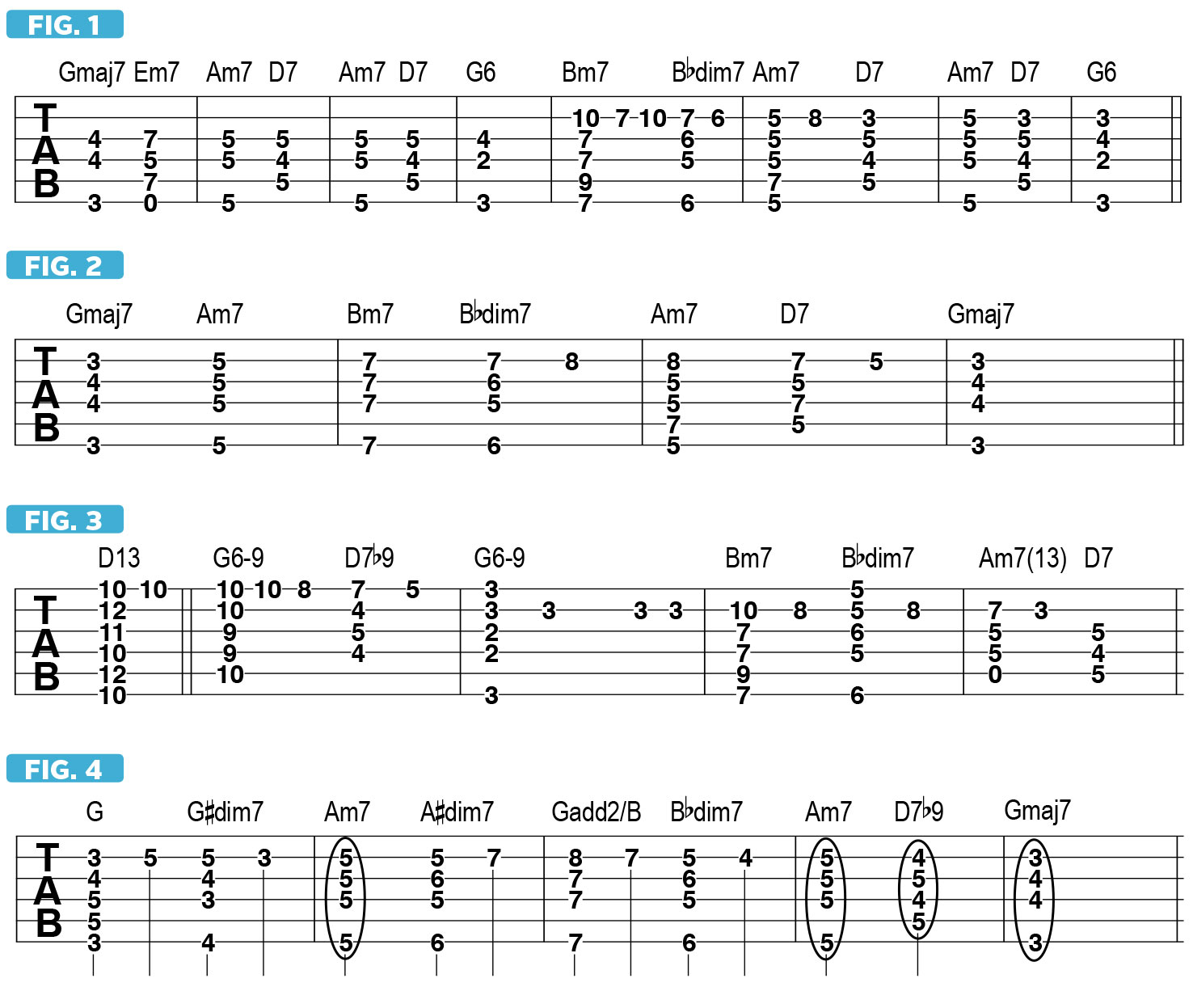The Ultimate Transition Chord, Part 3: Old-School, Jazzy Dim7 Resolutions
Learn how to employ this restless yet alluring chord as a musical attention grabber.
My final treatise on diminished seven chords. I promise.
In the previous four lessons, we looked at several ways in which dim7 has been used in progressions, such as to approach a minor or major chord from a half-step below, and how it may be superimposed over the V (five) chord, rooted a half step below, to form a tense-and tart-sounding dominant seven flat-nine. (For example, playing Fdim7 over an E bass note gives you E7b9.) I’ll wrap up this topic now by pointing out a couple more interesting ways in which composers have employed this restless yet somehow alluring chord as a musical attention grabber, this time in the context of a couple of old-school jazz standards and an enduringly popular holiday-themed song from the mid 20th century, the latter of which should no doubt be familiar to most of you.
A common chord move used by songwriters back in the Thirties was to insert a dim7 as a descending passing chord, placed between a major key’s three-minor-seven (iii7) and two-minor-seven (ii7), which makes it “biiidim7” (flat-three diminished seven). For example, in the key of G major, Bm7 to Bbdim7 to Am7. A good example of this change can be found in the nice old song “I’m in the Mood for Love,” which has been famously covered many times since it was written by Jimmy McHugh back in 1935.
Presented in the music theory-friendly key of G, FIGURE 1 sketches out the basic progression for the part of the verse that leads up to the lyrics “Funny, but when you’re near me” (bars 6 and 7), with the Bbdim7 chord falling specifically on the words “when you’re.” Interestingly, the high F# note in the voicing (B string, seventh fret) is actually not a chord tone of Bbdim7 (Bb Db E G), but rather a harmonic or melodic “extension” above the E note, one that’s theoretically derived from the Bb whole-half diminished scale (Bb C Db Eb E F# G A). And the F note that immediately follows (sixth fret) is just a chromatic passing tone between F# and E, which creates a smooth “walk down.” This goes to show that a melody note doesn’t always have to be a chord tone, or even a related scale tone, to work well.
A similar chord change occurs in another enduringly popular jazz standard from 1935, “My Romance,” written by Richard Rodgers and Lorenz Hart. In this case, staying in the key of G major for the sake of comparison, we have the same F# melody note over the passing Bbdim7 chord as in the previous example, but here that note then goes up a half step to G, staying within the whole-half diminished scale. FIGURE 2 illustrates this move, in bar 2.

That old perennial holiday favorite “Let it Snow! Let it Snow! Let it Snow!,” written by Jule Styne and Sammy Cahn in 1945, features this same kind of brief but heartwarming three-chord move, as depicted in FIGURE 3, again in the key of G for ease of comparison with the previous examples. Here, the first melody note over Bb dim7, A (first string, fifth fret) falls on what would be the major seventh interval relative to the Bb root, which works well because that note lives within the Bb whole-half scale, a half step below the octave Bb root.
To summarize, when using a dim7 chord in a major-key progression, whether as a biii, or, as we saw last month, a #IV between the IV and I, such as in the slow bluesy, gospel-style song “Please Be Home for Christmas,” or as a bii (or #i) between the I and ii chords, as in “Friends in Low Places” and “Bennie and the Jets,” you can always “extend” the top note of the dim7 voicing up a whole step or down a half step, in a “sus”-like manner, as further demonstrated by the short, original chord/melody-style phrase offered in FIGURE 4.
Senior Music Editor "Downtown" Jimmy Brown is an experienced, working guitarist, performer and private teacher in the greater NYC area whose professional mission is to entertain, enlighten and inspire people with his guitar playing.
Get The Pick Newsletter
All the latest guitar news, interviews, lessons, reviews, deals and more, direct to your inbox!
Over the past 30 years, Jimmy Brown has built a reputation as one of the world's finest music educators, through his work as a transcriber and Senior Music Editor for Guitar World magazine and Lessons Editor for its sister publication, Guitar Player. In addition to these roles, Jimmy is also a busy working musician, performing regularly in the greater New York City area. Jimmy earned a Bachelor of Music degree in Jazz Studies and Performance and Music Management from William Paterson University in 1989. He is also an experienced private guitar teacher and an accomplished writer.








![Joe Bonamassa [left] wears a deep blue suit and polka-dotted shirt and plays his green refin Strat; the late Irish blues legend Rory Gallagher [right] screams and inflicts some punishment on his heavily worn number one Stratocaster.](https://cdn.mos.cms.futurecdn.net/cw28h7UBcTVfTLs7p7eiLe.jpg)


